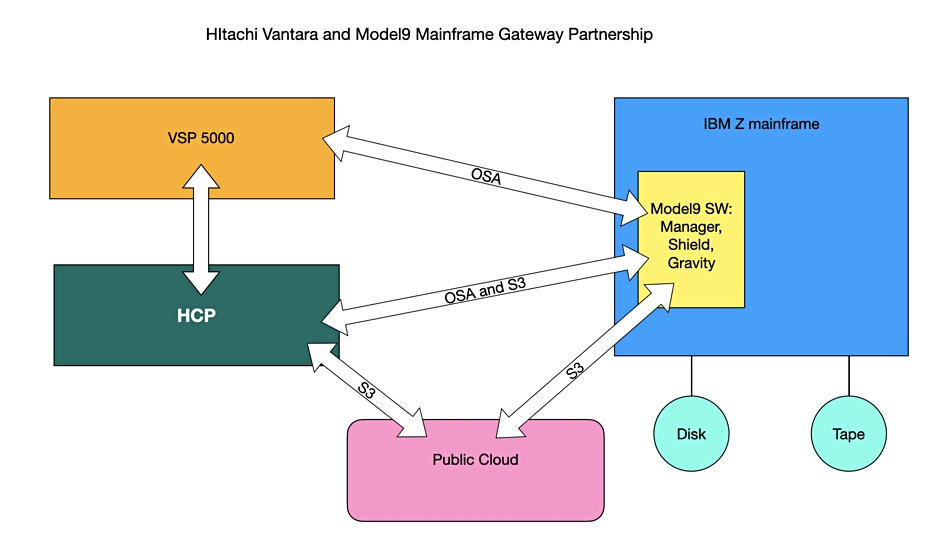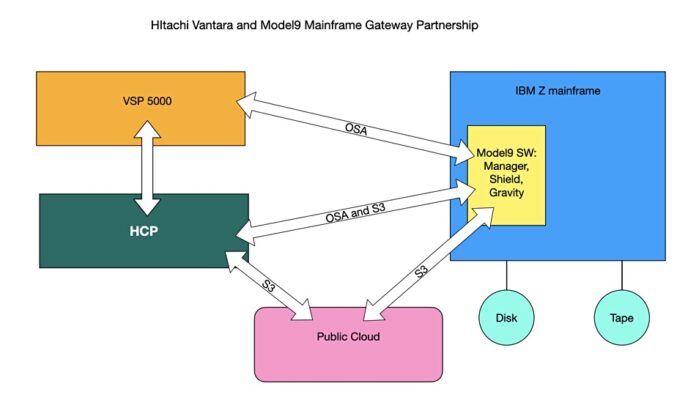Hitachi Vantara is collaborating with Model9 to feed mainframe data to its HCP and VSP 5000 storage systems and make it available to modern apps running in the hybrid cloud.
Update: OSA definition corrected to read Open Systems Adapters. 19 January 2023.
Model9 moves mainframe data to other systems, initially replacing mainframe tape storage with disk-based Virtual Tape Libraries, and then sending it with the S3 protocol to AWS and S3-supporting on-premises object storage systems. Hitachi Vantara has an S3-compliant object storage system, the Hitachi Content Platform (HCP), and a unified block and file high-end storage array product line, the VSP 5000.
Mark Ablett, president of Digital Infrastructure at Hitachi Vantara, said in a canned statement: “The dilemma for many organizations is that on-premises data is siloed, and access to legacy data on tape backups is difficult. Combining our VSP 5000 series and HCP storage portfolio with Model9’s software provides many benefits including protected backup copies, recovering and restoring data quickly and replacing costly virtual tape hardware with affordable cloud storage.”
Affordable cloud storage here means the public cloud and HCP system, with HCP able to tier to the public cloud.

The Model9 software has three components: Manager, to move and store backup/archive data in the cloud; Shield, to cyber-protect copies of mainframe data; and Gravity, to move mainframe data to the cloud and there transform and load it into cloud data warehouses and AI/ML pipelines.
We should envisage mainframe-using customers wanting to bring modern analytics and other applications to their mainframe data. Unfortunately, such applications don’t run on the mainframe and the mainframe data has to be moved to systems they can access. Model9’s software acts as the data mover for this.
The software runs on Z using the dedicated zIIP processor, typically DFHSM and FDRABR type products along with DFDSS, and sends data out, typically in S3 form, either to the public cloud, or to the HCP system across an OSA link. OSA stands for Open Systems Adapters, the mainframe’s tcp/ip networking cards.
Hitachi Vantara says the partnership brings “additional capabilities to the Hitachi Virtual Storage Platform (VSP) 5000 series and Hitachi Content Platform (HCP) object storage portfolio.”
Asked about this, a spokesperson told us: “The primary data can be on a VSP5000. The customer can take copies of that data using Hitachi V’s ShadowImage capability which is then backed up to the HCP via the mainframe using the OSA links. The Model9 processing is done in the zIIPs. Model9 has a capability to write to SAN but most customers want to write to object storage.”
Model9 and Hitachi V point out that 71 percent of Fortune 500 companies host their critical IT on a mainframe. Model9 says that, as more businesses undertake mainframe modernization, the most important IT operating factor for businesses was to create a single point of data management across hybrid environments. The two claim moving data to the hybrid cloud can be difficult and risky with concerns such as securing data in transit, the volume of data involved, the ability to fully access and gain value from that data, and the fear of breaking applications that are functioning well.
Model9 and Hitachi V say their collaboration makes mainframe data available and accessible for both hybrid cloud applications and predictive analytics services. They breach the mainframe silo and bring its previously closed-off data into the modern hybrid cloud world with x86-based applications doing so much more than ones in the narrow mainframe ecosystem.
Bootnote
In June 2021, Model9 set up a Growth Advisory Board to help guide its global expansion and deepen industry awareness of its data movement and management capabilities. It included Brian Householder, former president and CEO of Hitachi Vantara, as a member. And now we have a Model9 partnership with Hitachi Vantara.








